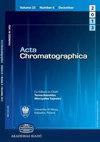Green RP-HPLC methods for assay and related substances in rivaroxaban tablets
IF 1.7
4区 化学
Q3 CHEMISTRY, ANALYTICAL
引用次数: 0
Abstract
In this study, two different ethanol-based RP-HPLC methods for assay and quantification of rivaroxaban related substances in tablets were developed, based on green analytical chemistry (GAC) principles, using the design of experiments approach. The chromatographic separation was performed on X-Bridge C18 column (250 × 4.6 mm, 5 µm particle size), using isocratic elution with ethanol : water (35:65, % v/v) for the assay and gradient elution with ethanol/water mobile phase, for related substances, with a flow rate of 1.0 mL min−1. The gradient method was optimized for the separation of three specified impurities (impurity G, impurity H, and impurity 14) and the selectivity was further confirmed using forced degradation studies. Both methods were validated in accordance with ICH guidelines. The robustness of the methods was confirmed with the Central Composite Face Design of Experiments. Analytical Eco-scale approach and AGREE metrics confirmed that both methods are in accordance with the GAC principles. The proposed ethanol-based RP-HPLC methods were applied for assay and determination of related substances in rivaroxaban 10 mg tablets obtained from three different manufacturers available on the Macedonian market.利伐沙班片中相关物质的绿色 RP-HPLC 检测方法
本研究根据绿色分析化学(GAC)原理,采用实验设计法,开发了两种不同的基于乙醇的 RP-HPLC 方法,用于片剂中利伐沙班相关物质的检测和定量。色谱分离采用 X-Bridge C18 色谱柱(250 × 4.6 mm,5 µm 粒径),检测时使用乙醇:水(35:65,% v/v)进行等度洗脱,相关物质使用乙醇/水流动相进行梯度洗脱,流速为 1.0 mL min-1。对梯度法进行了优化,以分离三种特定杂质(杂质 G、杂质 H 和杂质 14),并通过强制降解研究进一步确认了其选择性。两种方法均按照 ICH 指南进行了验证。采用中央复合实验设计法确认了这两种方法的稳健性。分析生态尺度法和 AGREE 指标证实这两种方法都符合 GAC 原则。所提出的基于乙醇的 RP-HPLC 方法被应用于利伐沙班 10 毫克片剂中相关物质的检测和测定,这些利伐沙班 10 毫克片剂来自马其顿市场上的三个不同制造商。
本文章由计算机程序翻译,如有差异,请以英文原文为准。
求助全文
约1分钟内获得全文
求助全文
来源期刊

Acta Chromatographica
化学-分析化学
CiteScore
4.00
自引率
0.00%
发文量
55
审稿时长
2.3 months
期刊介绍:
Acta Chromatographica
Open Access
Acta Chromatographica publishes peer-reviewed scientific articles on every field of chromatography, including theory of chromatography; progress in synthesis and characterization of new stationary phases; chromatography of organic, inorganic and complex compounds; enantioseparation and chromatography of chiral compounds; applications of chromatography in biology, pharmacy, medicine, and food analysis; environmental applications of chromatography; analytical and physico-chemical aspects of sample preparation for chromatography; hyphenated and combined techniques; chemometrics and its applications in separation science.
 求助内容:
求助内容: 应助结果提醒方式:
应助结果提醒方式:


